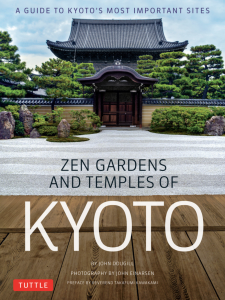JQ Magazine: Book Review — ‘Zen Gardens and Temples of Kyoto’
By Rashaad Jorden (Yamagata–ken, 2008-10) for JQ magazine. A former head of the JETAA Philadelphia Sub–Chapter, Rashaad is a graduate of Leeds Beckett University with a master’s degree in responsible tourism management. For more on his life abroad and enthusiasm for taiko drumming, visit his blog at www.gettingpounded.wordpress.com.
Kyoto has served as the focal point of Japanese cultural forms such as geisha, noh theater and ikebana. And as John Dougill thoroughly details in Zen Gardens and Temples of Kyoto, the city has played an enormous role in the development of Zen in Japan.
A professor at Kyoto’s largest Buddhist university, Dougill explores the ties between Japan’s former capital and the Buddhist sect in this guide to Kyoto’s most prominent Zen gardens and temple sites. While not the birthplace of Zen in Japan, Kyoto could be considered its soul as the city has long housed renowned temples where visitors and monks have sought serenity.
At first glance, such a book would seem to be a largely visual journal featuring a score of beautiful places. Zen Gardens doesn’t disappoint in that regard as photographer John Einarsen captures the splendor of some very spiritual places. But it’s clear early on that the book will rely primarily on stories to chronicle the story of Zen in Kyoto—not surprising since Dougill has previously written about Japan’s World Heritage Sites and Kyoto’s history.
Indeed, the first half of the book is devoted to the relationship between Zen and Japanese history and culture (in which we learn that the sect originated in China and arrived in Japan in the early 1200s). Dougill tries to find a happy medium between educating readers about Zen’s past and not solely living in previous centuries. Zen Gardens includes chapters detailing the daily routines of Zen monks as well as Kyoto temple culture. An American monk (and caretaker of Rinsen-ji in Niigata) named Thomas Kirchner is also interviewed for the book. But with chapters highlighting, among other things, the traditional design of Zen temple-monasteries and the origin of the tea ceremony, the first part of Zen Gardens will largely appeal to hardcore Japanese history buffs.
The second half of Zen Gardens has touches of a travel guide as Dougill profiles 35 temples and sub-temples (as expected, Kinkaku-ji and Ginkaku-ji both appear). He also includes small inserts for each locale with information of interest to potential visitors. But despite those nuggets, Zen Gardens is nowhere near an endless parade of “what to see and do” recommendations for the places the reader discovers.
Similar to the first half of the book, Dougill uses history as a key tool to illuminate the temples. The information does have its lively moments: he introduces readers to Takafumi Kawakumi, an American-educated son of the head priest at Shunko-in who has taught Zen in English and served as an LGBT rights activist. Kawakaumi isn’t the most noteworthy name to appear in the write-ups of the temples—Saiho-ji has attracted the likes of Steve Jobs and Richard Gere. Their fame certainly made it easier for visiting its renowned moss garden, which for the past 30 years has required guests to make reservations by postcard.
But even if you don’t get anywhere near any of the spots profiled in Zen Gardens, Dougill’s words will give you as majestic a view as your eyes could: the author vividly captures the scenery visitors are mesmerized by, so it’s best for you to follow the path set out by the author as you imagine yourself exploring Kyoto.
While Zen Gardens can be challenging to grasp, there is magic to behold.
For more on Zen Gardens and Temples of Kyoto, click here.
For more JQ magazine book reviews, click here.



Comments are closed.